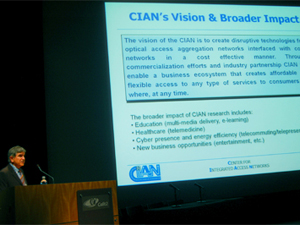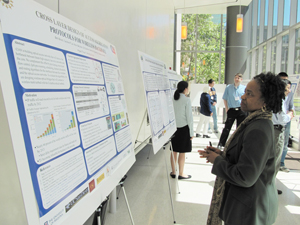NSF Reviews CIAN's Efforts to Create Transformative Optical Technologies
San Diego, Calif., May 27, 2010 — Let’s say you want to travel from San Diego to New York City to visit a friend. You might walk from your home to the nearest bus stop, take the bus to the train station, take the train to the airport, or use any combination of these “access networks” to eventually catch your transcontinental flight.
|
"Access networks” in the world of telecommunications work in much the same way — they are short paths that connect users to the fiber optics backbone. The trouble is, many of these access networks were developed independently and are not always the most efficient means to accommodate ever-increasing multimedia traffic.
The Center for Integrated Access Networks (CIAN), a collaboration of the University of Arizona, the University of California, San Diego, and a number of other institutions of higher learning, is working to re-architect these access networks using optical and opto-electronic technologies.
"CIAN is focused on the innovations that are necessary to reframe the problems of access networks and determine if there's a common protocol for optics,” explained CIAN Deputy Director Shaya Fainman, a professor of electrical and computer engineering at UC San Diego. “Our vision is to develop novel optical networking architectures, create low-cost optoelectronic technologies, test them through our unique testbed infrastructure, prove their relevance and commercialize them through entrepreneurs and industrial partners."
"For consumers, this means that eventually these access networks can be interfaced with core networks in a cost-effective manner," added the project's Director of Strategic Initiatives, Srinivas Sukumar of Calit2. “That means their gadgets will be faster, less expensive and capable of handling more data."
At their second-annual review by the National Science Foundation (which funds CIAN as an Engineering Research Center, or ERC), CIAN researchers presented their vision and strategies in the company of affiliates from academia and industry.
"The NSF site visit was an exciting scientific exchange,” remarked Fainman. “The fruitful interactions between the review board and the CIAN team members helped to better focus our research activities and the connections between the different thrusts of our project," which are: 1) Optical Communication Systems and Networking 2) Subsystem Integration and Silicon Nanophotonics and 3) Materials and Devices.
As the CIAN team moves into its second year, it has established two working groups to integrate these thrusts: One to change the face (and the future) of data centers by introducing novel optical technologies, and the other to develop broadband technologies to integrate the many different access networks for cellular, voice and data before they reach the fiber-optic core backbone.
This structure — which guides CIAN intellectual pursuits — is the framework the NSF site review panel used to analyze CIAN’s broader impacts.
The panel found that with the rapid increase in Internet traffic and diversity of applications, CIAN’s work to develop a transformative, integrated, robust and flexible aggregate optical network could have a tremendous impact on society by enabling a wider spread of applications such as telemedicine, telepresence and video conferencing.
Calling it a “significant achievement,” the NSF panel acknowledged CIAN’s development of improved testbed capabilities that allow the advance of technological innovation and testing. UC San Diego's contribution to CIAN focuses primarily on its Scalable Energy Efficient Datacenter (SEED) testbed, which will improve the way datacenters deliver large aggregate communication bandwidth between arbitrary nodes. Researchers at the University of Arizona, for example, are developing a new switching technology that will go on to be packaged in a packaging facility at UC Berkeley. It will then be inserted into a chip-scale photonic testing facility at UC San Diego, where it will be tested as a viable substitute for current commercial switching components and eventually inserted into the SEED testbed.
Leading this effort at UCSD (along with Prof. Fainman) are Computer Science and Engineering Professor Amin Vahdat and Electrical Engineering Professor George Papen.
|
"The advantage is that this switch will be orders of magnitude faster and lower cost," noted Fainman. "Its evaluation will help to provide necessary feedback to material and device engineers for further development. It basically closes the research and development loop."
A second CIAN working group is developing broadband technologies to integrate the many different access networks for cellular, voice and data before they reach the fiber-optic core backbone. Such an overhaul is necessary in light of the many bandwidth-intensive applications – like videoconferencing, remote surgery and 3-D visualization of large datasets – that are becoming increasingly commonplace. This group will also develop new algorithms, architectures and system technologies to monitor and manage this new infrastructure.
The NSF review panel also acknowledged CIAN’s development of several novel fundamental concepts, such as optomechanical crystals, sub-wavelength scale nano lasers, and photon-phonon conversion for optical information storage.
CIAN’s education programs — which offer K-12 students, undergraduates and graduates the opportunity to develop basic engineering skills — were also praised by NSF, although the panel encouraged CIAN to integrate these three educational outreach more fully and identify shared needs and key strategic directions for these efforts. A key next step will be to measure the impact of these programs to prove their value to others in the educational research community, and determine effective ways to disseminate the most transformative programs so other institutions can broadly adopt them.
"We've structured these educational programs in such a way that we've tailored the information to suit the maturity and ability of students," remarked Fainman. "Eventually, we would love to see CIAN-associated grad students turn into entrepreneurs, develop this technology and take it to market."
Added Sukumar: "If we are successful and the technologies are widely adapted by the industry ecosystem, then the cost and scaling will happen just like with PC industry. These new technologies will become more pervasive and the costs will come down."
Related Links
Center for Integrated Access Networks (CIAN)
National Science Foundation
Media Contacts
Tiffany Fox, (858) 246-0353, tfox@ucsd.edu


